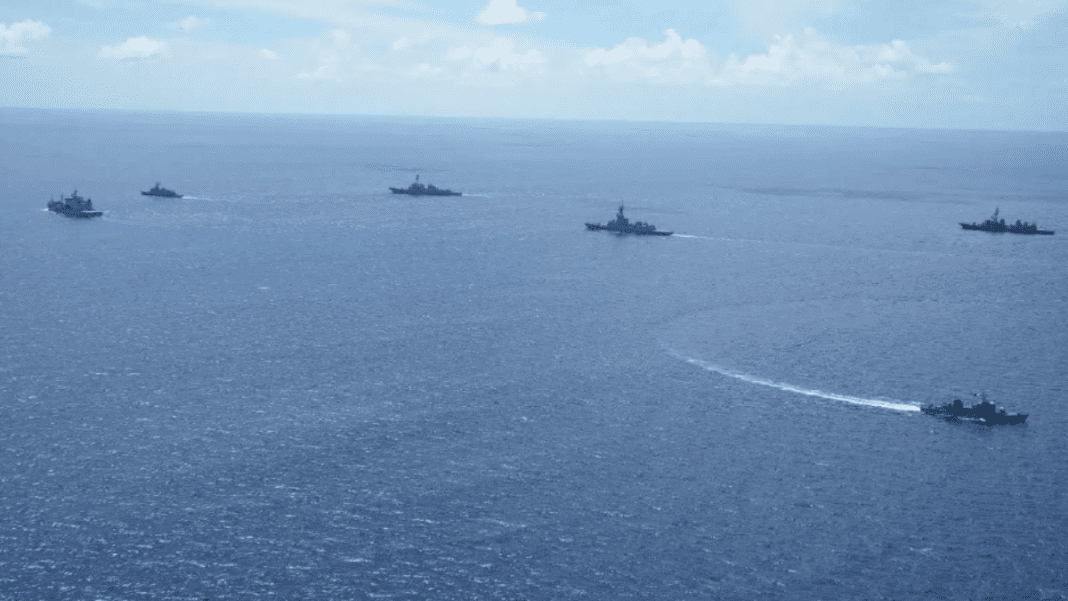The naval forces of the Philippines, Australia, and Canada carried out a joint patrol in the South China Sea on Tuesday. The timing of this activity was significant, as it came just one week after a collision involving two Chinese vessels heightened tensions in the region.
Joint Patrol Marks a Strong Presence in Disputed Waters
The three warships participating in the joint patrol were the Philippine frigate BRP Jose Rizal, the Australian destroyer HMAS Brisbane, and the Canadian frigate HMCS Ville de Quebec. Military officials emphasized that they did not aim the operation at any particular country. They described it as a show of cooperation. It was also meant to demonstrate a commitment to peace. The goal was to help maintain stability across the Indo-Pacific region.
The joint patrol took place within the Philippines’ exclusive economic zone, a large stretch of sea where the Philippines has the right to explore and use natural resources. Officials explained that the patrol was part of efforts to ensure the Indo-Pacific remains free and open. In simpler terms, this means that ships from all nations should be able to pass through these waters without restrictions or threats.
🔥 From Manila to the South China Sea: Is the Indo-Pacific on the Edge of a Naval Flashpoint?
The South China Sea is one of the busiest maritime routes in the world. It is estimated that about $3 trillion worth of trade passes through these waters every year, making it an area of global importance. Any rise in tension here has the potential to affect international shipping and commerce.
ALON Exercises Bring Together International Partners
The joint patrol was part of the broader ALON 2024 exercises, a combined training program between the Philippines and Australia. The word “ALON,” which translates to “wave” in Filipino, reflects the idea of cooperation and strength in working together.
The ALON drills began on August 15 and will continue for 15 days. This year marks the largest version of the exercises so far, with around 3,600 troops taking part. The activities include amphibious operations, land-based exercises, and live-fire training. The exercises are designed to improve the ability of the two forces to work side by side. They cover both training and real-world situations.
The joint patrol was one of the highlights. It showed how multiple navies could come together for a common goal.
Philippines Arrests 5 More Chinese Spies in Escalating South China Sea Dispute
For the first time, the drills also included a Canadian Navy contingent. US Marines joined as well. This expanded the reach of the training beyond just the Philippines and Australia.
The training began in the province of Oriental Mindoro. It is scheduled to conclude in Palawan. Palawan is a Philippine province that faces the South China Sea. Its location makes it a strategic point for maritime activities.
ALON was first launched in 2023. That was also the year when the Philippines and Australia strengthened their defense ties. They upgraded their relationship to a strategic partnership. This move came as regional challenges in the South China Sea became more visible.
Philippines Expands Joint Patrols in Regional Waters
Over the past year, the Philippines has been steadily increasing the frequency of its joint patrols with other nations. These activities include cooperative passages and exercises that are aimed at showing unity among allies and partners.
Since late 2023, the Philippines has carried out joint patrols with its treaty ally, the United States. It has also worked with Canada, Japan, and most recently, India. Earlier this month, the Philippines and India held a joint patrol in the South China Sea for the very first time, marking another step in building international cooperation.
The South China Sea remains one of the most contested areas in Asia, with overlapping territorial claims and frequent maritime incidents. The Australia-Canada-Philippines joint patrol underlined the importance of keeping sea lanes open and free from disruption.
China Tightens Grip on Reef Territory After Detaining Filipinos in South China Sea
The presence of multiple navies in the same waters, just days after the Chinese vessel collision, added weight to the patrol’s timing. While the operation was not intended as a message to any specific country, it drew attention because of the increasing importance of collective action in the region.
By combining exercises like ALON with visible maritime operations such as joint patrols, the Philippines and its partners demonstrated their shared interest in ensuring peace, stability, and uninterrupted trade flow in one of the world’s most important waterways.

